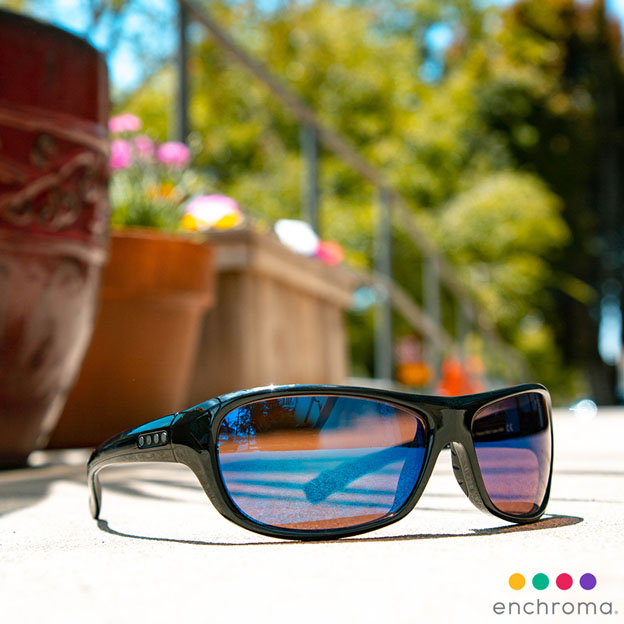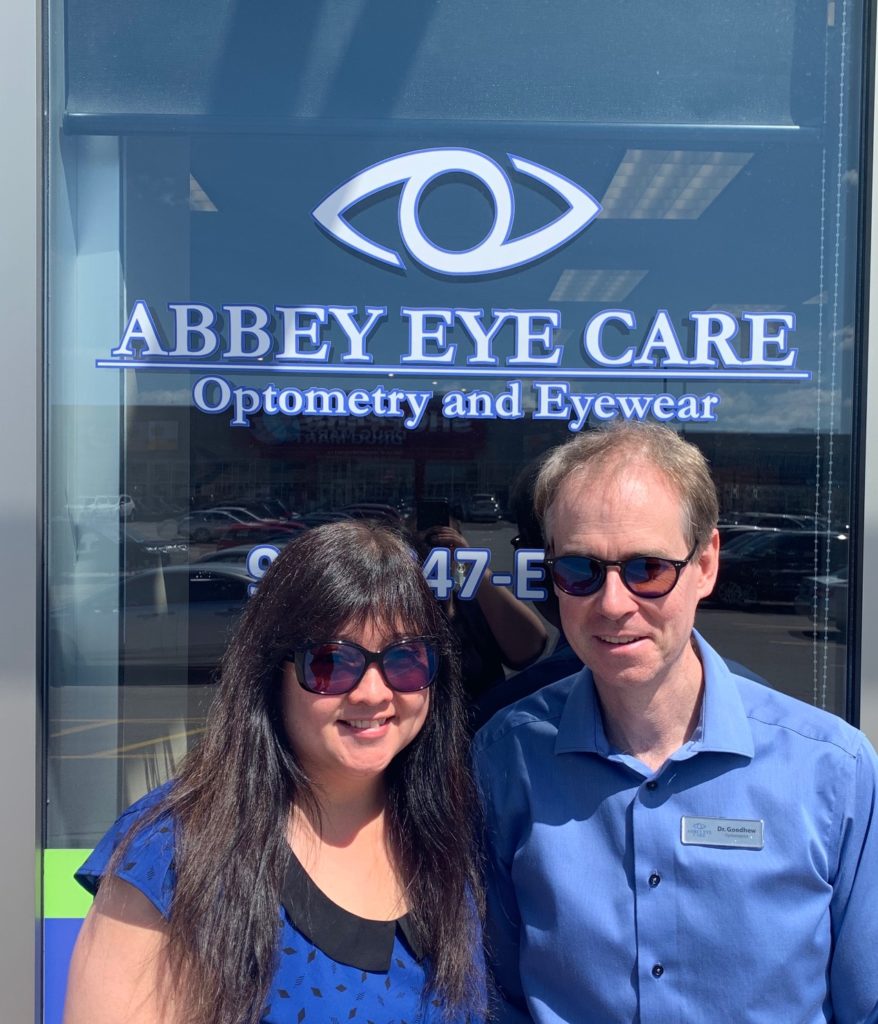
EnChroma Monterey Outdoor Sunglasses
Sponsored Content
By Mark Mattison-Shupnick, Master Optician
Sept. 4, 2019
Color blindness is an age-old problem with a brand-new solution for patients.
ECPs historically have had little to offer, or say, to color-blind patients hoping for something to help them with the challenges of their condition, says Tina Goodhew, OD. “That picture has changed with EnChroma glasses,” she says. “We now have the ability to help people with red-green color blindness, but what’s equally interesting and exciting is how serving the color blind has inspired our staff and boosted our practice overall.”
State-of-the-Art Solution to Old Problem
EnChroma, Inc. – creator of glasses for color blindness – supports a network of more than 240 Authorized EnChroma Retailers in the U.S. and Canada. One of those network members is Abbey Eye Care, an independent full-service optometry practice and eyewear boutique in Oakville, Ontario.
Opened in 2005 by Dr. Goodhew and her husband, Jeff Goodhew, OD, Abbey offers a comprehensive approach to primary eyecare, but has also developed several niche offerings including myopia control, glaucoma management and dry-eye therapy. In January 2018, after investigating options for patients with color-vision deficiency, the Drs. Goodhews launched a color-vision deficiency program featuring a full line of EnChroma glasses for color blindness.

Drs. Tina and Jeff Goodhew. The doctors have found EnChroma lenses to be a solution both their patients and practice can get happily behind.
“Our goal at Abbey is to offer a state-of-the-art approach to eyecare, and we’ve been excited to be able to offer color-vision deficient patients an array of EnChroma lens options to help them overcome the obstacles posed by color blindness,” says Dr. Jeff Goodhew, former president of the Ontario Association of Optometrists. “Carrying EnChroma has generated revenues and foot traffic, but the emotional impact the glasses can have for people with color-vision deficiency has also deeply touched our staff.”
Color blindness affects one in 12 men (8 percent), and one in 200 women (.5 percent) – roughly 300 million people worldwide, and an estimated 13 million in the U.S. and 1.5 million in Canada. EnChroma lenses enable red-green color blind people to see color clearly and vibrantly. Special optical filters in the lenses remove small slices of light from the spectrum to enable the color blind to participate more fully in life’s colorful moments.
Patient Demand for a Solution
Dr. Tina Goodhew notes that there was a tremendous pent up demand for the EnChroma glasses in Ontario – a market of almost 15 million people. “Although EnChroma glasses are also available online, many people want to speak directly with their ECP about the benefits and how the glasses work, and then try them in person to experience the difference,” she says.
“We developed a clear process for the fitting and sales of EnChroma eyewear and ensured that everyone was well trained using the personal training provided by EnChroma. When we flipped the switch and went live, the response was overwhelmingly positive,” adds Dr. Jeff Goodhew.
After Abbey Eyecare’s connection to EnChroma was featured in the Toronto media, traffic to the Abbey web site jumped by almost 90 percent for the first month. “In the first month alone, 40 people came into the store to try on the glasses and more than 20 purchased them.”
A Solution Support Staff Can Get Behind
Drs. Goodhews observed early on that carrying EnChroma glasses would also have subjective benefits. “Starting with the very first person who came in the door and put on the EnChroma glasses, we saw what a positive impact the new offering was going to have on the entire staff,” says Dr. Tina Goodhew. “There’s a lot of satisfaction in being able to help people to see colors more distinctly and clearly in what can be a very emotional and heart-warming experience for all concerned.”
Certified Optometric Assistants Jessica Ferreira and Melissa Rae Emuss, have taken an active role in the introduction of EnChroma to Abbey’s color-vision deficient patients. “It’s been amazing the way people have identified us as a resource for the EnChroma glasses,” says Ferreira. “Because we carry a full line of EnChroma lenses and styles and have the expertise to guide them through the testing and selection process, we’ve become a one-stop shop for those with color blindness in our region.”
Emuss notes that while some people prefer to buy directly online from EnChroma, others like the option of coming in for an evaluation and taking advantage of Abbey’s expertise. “Every person is different. Before administering the color-vision test, we ask each patient what they’ll be using the glasses for and about the colors that they struggle with,” she says. “We’ve gained so much experience administering EnChroma’s color-vision test that we can help guide the patient to the lenses that will work best for them in a fast and efficient way.”
More Choices Than Ever
The added value provided by a full-service EnChroma Authorized Retailer like Abbey Eye Care was enhanced when EnChroma launched an expansion to its line of lenses. The three new lenses EnChroma added to its existing three-lens offering brought to six the total number of specially engineered lenses to address specific types and severities of red-green color blindness in a broad range of lighting conditions.
The Enchroma research team, not surprisingly, found that the optimal lens choice often depends on the type and extent of color-vision deficiency and the expected use conditions. Patients have an opportunity to try on each of the lenses using the EnChroma Demonstration Kit to find the lens that works best for them. Ferreira says that one of her most important roles when interacting with a new patient is to help manage expectations when it comes to trying on the glasses.
There are various types and degrees of color-vision deficiency and EnChroma’s research shows that four out of five red-green color blind people benefit. “Some people come in expecting to experience the kind of ‘Wow’ moment that they’ve seen in a viral video on the internet,” Ferreira says. “We do have some patients experience those, but for most people the change is more gradual. Their brains need a chance to get used to the glasses.” She notes that she and her colleagues have learned to stand back and let the patient take their time and experience EnChroma for themselves.
To hear other ECPs discuss how EnChroma eyewear has helped their practices, please join us at Vision Expo West for this special panel discussion: ENCHROMA, COLOR BLINDNESS AND YOUR PRACTICE, Understanding Opportunities to Serve the Color Blind Community, on Friday, Sept. 20, 10-11 a.m. at EnChroma booth #19077. Learn more about EnChroma at enchroma.com.
Mark Mattison-Shupnick, Master Optician, ABO, is the vice-president, Business Development for EnChroma, a producer of eyeglasses that uses a patented science-based solution to produce and sell lenses for color blindness. Mark manages the international EnChroma business and contributes daily to the company’s operations. With over 50 years in the optical industry, Mark helps manage the growth and product development at EnChroma. Previously to EnChroma, Mark was Director, Education for 20/20 Magazine as part of Jobson Medical Information LLC. Mark is a Master Optician, as certified by the American Board of Opticianry, has been appointed to the Opticianry Hall of Fame and is the recipient of the Beverly Myers Award for Education from the National Academy of Opticianry. To contact him: send an e-mail to mark@enchroma.com

























